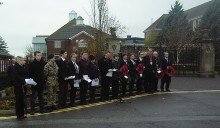With forecasts of heavy rain imminent, the annual Act of Remembrance on the morning of 11 November was attended by a representative gathering of staff and students, in silent tribute in front of The Thomas Hardye School memorial gates in Queens Avenue, Dorchester. Head Teacher Michael Foley led the minute’s silence and a brief Act of Remembrance, culminating in the last post sounded by the bugler. Two detachments of the Combined Cadet Corps were on parade. Councillor Peter Mann, Mayor of Dorchester, attended the occasion.
The names of all Old Grammarians and Old Hardyeans who gave their lives in armed conflict were read- particularly relevant on the centenary of the start of the Great War.
The tradition began in 1957 at Hardye’s School and has continued at the modern Thomas Hardye School.
Around 30 old boys from the former schools were at the commemoration, Old Grammarians and Old Hardyeans led by President Peter Foster, who laid a wreath.
“It was 54 years ago- in 1960- that I attended my first Act of Remembrance outside those handsome iron gates and the stone pillars with the wyverns on top, then in Culliford Road,” reminisces Old Hardyeans’ Secretary Michel Hooper-Immins. “I recall it snowed that day in November 1960 and we all got very cold! It makes me and all the other old boys very proud that today’s young students still remember the sacrifice of former students lost in action and in such a dignified manner.”
Thomas Hardye School is thought to be the only school in the South and South West to maintain this respectful tradition. It began when the stone pillars and iron gates were consecrated in 1957 at Hardye’s School in Culliford Road. The Memorial Gates and pillars were rescued from the old school in 1995, before it was demolished and re-erected outside the new Thomas Hardye’s School at the end of Queens Avenue, complete with the twin stone wyverns- the School’s historic symbol- carved by the late Ken Batty, art master for many years.
The pillar alongside the memorial gates reads: “This memorial to those whose names are inscribed on the Rolls of Honour was erected by the old boys, parents and Governors. Dedicated 18 July 1957.” Inside the new School are two rolls of honour, one for Old Grammarians who fell in the Great War and the other honouring those in subsequent conflicts from 1939.
Founded in 1905 as the Old Grammarians, the Old Hardyeans- also known as the Hardyeans Club- is one of the most successful old school associations in the county, bringing together the old boys of Dorchester Grammar School and Hardye’s School, plus ex-students of the modern Thomas Hardye School. In the times of Queen Elizabeth I, it was Thomas Hardye [with a final “e”] described as a Yeoman of Frampton, who endowed Dorchester Grammar School in 1569. Hardye’s [shopping] Arcade today stands on the site. The Grammar School moved to Culliford Road in 1928- renamed Hardye’s School from 1954. The new Thomas Hardye School in Queens Avenue opened in 1992, encompassing the best traditions of the two previous schools- but admitting girls for the first time since 1569! Writer Thomas Hardy OM, who lived at nearby Max Gate, laid the foundation stone of Hardye’s School in 1927. He was no relation to Thomas Hardye, founder of the school, nor of Admiral Thomas Masterman Hardy!
Michel Hooper-Immins












